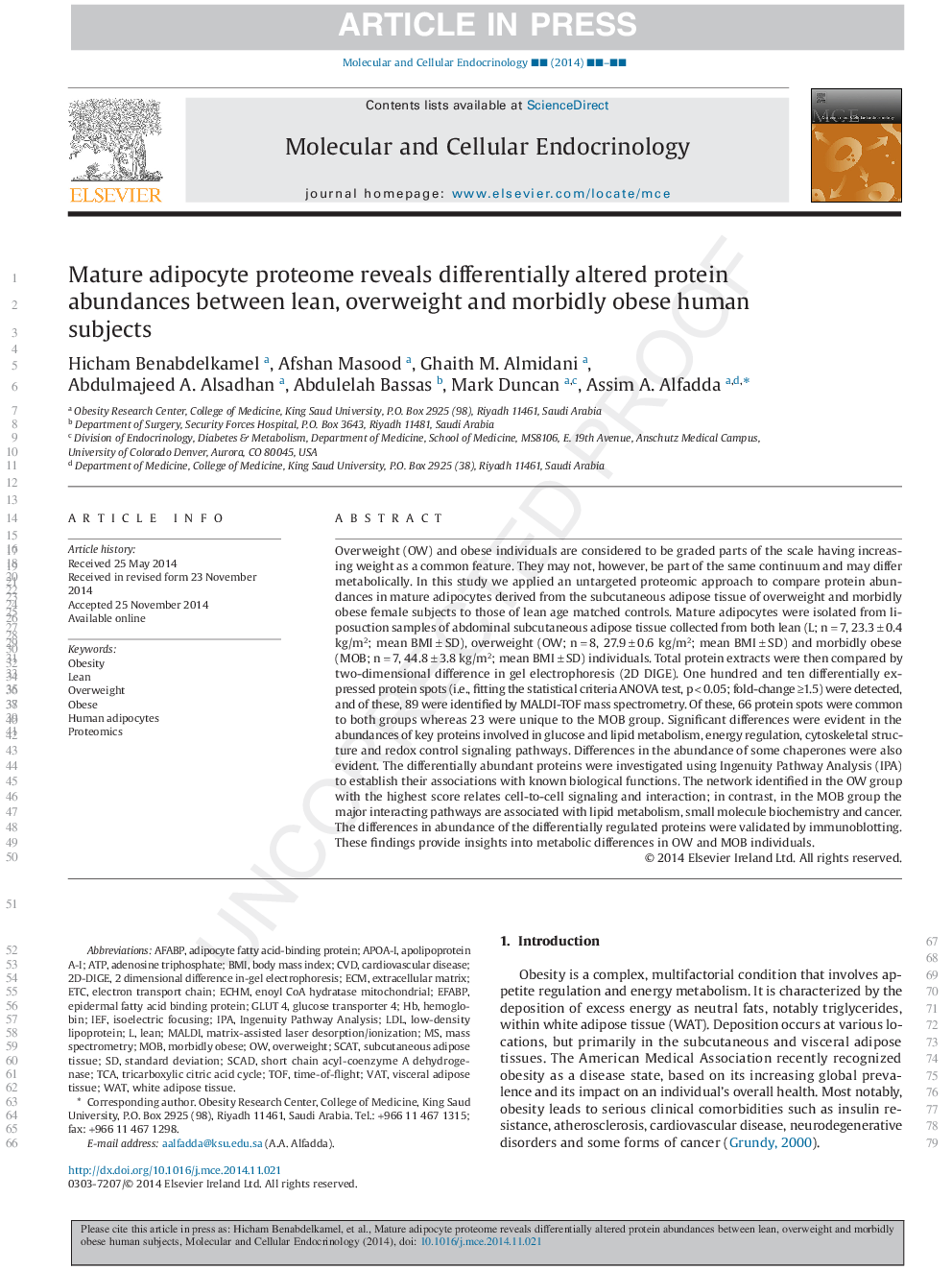| کد مقاله | کد نشریه | سال انتشار | مقاله انگلیسی | نسخه تمام متن |
|---|---|---|---|---|
| 8477092 | 1550877 | 2015 | 13 صفحه PDF | دانلود رایگان |
عنوان انگلیسی مقاله ISI
Mature adipocyte proteome reveals differentially altered protein abundances between lean, overweight and morbidly obese human subjects
ترجمه فارسی عنوان
پروتئوم بالغ مبتلا به آدیپوسیت نشان دهنده تغییرات فراوانی پروتئین در بین افراد نابینا، اضافه وزن و بیماریهای چاق مبتلا به چاقی است
دانلود مقاله + سفارش ترجمه
دانلود مقاله ISI انگلیسی
رایگان برای ایرانیان
کلمات کلیدی
ECMAFABPIPAIEFApoA-IMOBTCA2D-DIGE - 2D-دیگهAdenosine Triphosphate - آدنوزین تری فسفاتATP - آدنوزین تری فسفات یا ATPApolipoprotein A-I - آپولیپوپروتئین A-IscAT - اسکاتOverweight - اضافه وزنstandard deviation - انحراف معیارSubcutaneous adipose tissue - بافت چربی زیر پوستیcardiovascular disease - بیماری قلب و عروقیIngenuity Pathway Analysis - تجزیه و تحلیل راه Ingenuityisoelectric focusing - تمرکز ذره ای الکتریکیmatrix-assisted laser desorption/ionization - جذب / یونیزاسیون لیزر ماتریس کمک می کندglucose transporter 4 - حمل کننده گلوکز 4CVD - رسوب دهی شیمیایی بخار electron transport chain - زنجیره انتقال الکترونbody mass index - شاخص توده بدنBMI - شاخص توده بدنیMass spectrometry - طیف سنجی جرمیLean - لاغرLow-density lipoprotein - لیپوپروتئین کم چگالی یا الدیال LDL - لیپوپروتئین کم چگالی(کلسترول بد)Extracellular matrix - ماتریکس خارج سلولیMALDI - مالدیHemoglobin - هموگلوبینETc - و غیرهAdipocyte fatty acid-binding protein - پروتئین مرتبط با اسید چرب Adipocytemorbidly obese - چاقی مفرتScad - کاهشGlut 4 - گلو 4
موضوعات مرتبط
علوم زیستی و بیوفناوری
بیوشیمی، ژنتیک و زیست شناسی مولکولی
بیولوژی سلول
چکیده انگلیسی
Overweight (OW) and obese individuals are considered to be graded parts of the scale having increasing weight as a common feature. They may not, however, be part of the same continuum and may differ metabolically. In this study we applied an untargeted proteomic approach to compare protein abundances in mature adipocytes derived from the subcutaneous adipose tissue of overweight and morbidly obese female subjects to those of lean age matched controls. Mature adipocytes were isolated from liposuction samples of abdominal subcutaneous adipose tissue collected from both lean (L; nâ=â7, 23.3â±â0.4 kg/m2; mean BMIâ±âSD), overweight (OW; nâ=â8, 27.9â±â0.6 kg/m2; mean BMIâ±âSD) and morbidly obese (MOB; nâ=â7, 44.8â±â3.8âkg/m2; mean BMIâ±âSD) individuals. Total protein extracts were then compared by two-dimensional difference in gel electrophoresis (2D DIGE). One hundred and ten differentially expressed protein spots (i.e., fitting the statistical criteria ANOVA test, pâ<â0.05; fold-change â¥1.5) were detected, and of these, 89 were identified by MALDI-TOF mass spectrometry. Of these, 66 protein spots were common to both groups whereas 23 were unique to the MOB group. Significant differences were evident in the abundances of key proteins involved in glucose and lipid metabolism, energy regulation, cytoskeletal structure and redox control signaling pathways. Differences in the abundance of some chaperones were also evident. The differentially abundant proteins were investigated using Ingenuity Pathway Analysis (IPA) to establish their associations with known biological functions. The network identified in the OW group with the highest score relates to-: cell-to-cell signaling and interaction; in contrast, in the MOB group the major interacting pathways are associated with lipid metabolism, small molecule biochemistry and cancer. The differences in abundance of the differentially regulated proteins were validated by immunoblotting. These findings provide insights into metabolic differences in OW and MOB individuals.
ناشر
Database: Elsevier - ScienceDirect (ساینس دایرکت)
Journal: Molecular and Cellular Endocrinology - Volume 401, 5 February 2015, Pages 142-154
Journal: Molecular and Cellular Endocrinology - Volume 401, 5 February 2015, Pages 142-154
نویسندگان
Hicham Benabdelkamel, Afshan Masood, Ghaith M. Almidani, Abdulmajeed A. Alsadhan, Abdulelah F. Bassas, Mark W. Duncan, Assim A. Alfadda,
